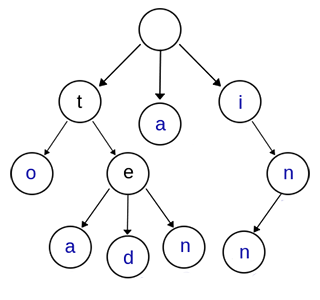Trie树的基本性质:
1、根节点 不包含任何字符,除根节点之外的任何一个节点都只包含一个 字符
2、从根节点到某一节点,将路径上的字符串连接起来,为该节点所对应的字符串。
3、每个节点的所有子节点包含的字符各不相同。
以{“a”, “to”, “tea”, “ted”, “ten”, “i”, “in”, “inn”} 集合构建trieTree树,该树构建完如下所示,

其中在每一个节点中,有一个count变量,来表示从根节点到该节点所代表的的字符串出现的次数。如果count=0,则代表不构成一个字符串。比如第三层最右边的节点中,count=1,此时表示”in”出现了一次;若节点还有子节点,则表示目前为止的字符串还没有结束。在本例中第三层最右边的节点还有子节点,表示”in”后边还有字符,该字符为”n”,字符串为为”inn”。
下边以集合{“the”, “a”, “there”, “answer”, “any”, “by”, “bye”, “their”,”the”}来构建trieTree
#include <iostream>
#include <string>
using namespace std;
const int Alphabet_Size=26; //定义字符个数
typedef struct trieTree
{
int count; //记录该节点代表的单词个数
trieTree* children[Alphabet_Size]; //各个子节点
}trieTree;
trieTree* create_trieTree_node()//创建trieTree节点
{
trieTree* root=new trieTree();
root->count=0;
for(int i=0;i<Alphabet_Size;i++)
{
root->children[i]=NULL;
}
return root;
}
void insert_trieTree(trieTree* root,string key)
{
trieTree* p=root;
for(int i=0;i<key.size();i++)
{
int index=key[i]-'a';
if(p->children[index]==NULL)
{
p->children[index]=create_trieTree_node();
}
p=p->children[index];//改变指针
}
p->count+=1;
}
int search_trieTree(trieTree* root,string key)
{
trieTree* p=root;
int i=0;
while( p && i<key.size() )
{
int index=key[i]-'a';
p=p->children[index];
++i;
}
//如果能找到key的话,那么p节点一定不为空
if( p!=NULL )
return p->count;
else
return 0;
}
int main()
{
char keys[][8]={"the", "a", "there", "answer", "any", "by", "bye", "their","the"};
trieTree* root=create_trieTree_node();
for(int i=0;i<9;i++) //创建trieTree
{
insert_trieTree(root,keys[i]);
}
printf("%s --- %d\n", "the", search_trieTree(root, "the") );
printf("%s --- %d\n", "these", search_trieTree(root, "these") );
printf("%s --- %d\n", "their", search_trieTree(root, "their") );
printf("%s --- %d\n", "thaw", search_trieTree(root, "thaw") );
return 0;
}






















 787
787

 被折叠的 条评论
为什么被折叠?
被折叠的 条评论
为什么被折叠?








